0 导语
近年来,大型海上风电场正成为清洁能源的发展热点,由于海上风电场通常离陆地较远,需要进行远距离、大容量电力传输,从技术和经济性角度来看,多端柔性直流(voltage source converter-based multi-terminal direct current,VSC-MTDC)输电系统是海上风电场并网的理想方式。随着风电渗透率不断提高,岸上交流系统旋转惯量和相应的频率调节能力不断降低。如果陆上交流系统没有足够的转动惯量,当有功功率突然变化引起的频率偏差和频率变化率足够大时,将会导致低频减载或发电机跳闸事件,甚至引起严重的连锁故障。因此,随着风电渗透率的不断增加,以及海上风电场工程建设,为保证系统的稳定运行,大规模海上风电场需具备参与陆上交流系统频率调节的能力。
Two-Level Combined Control Scheme of VSC-MTDC Integrated Offshore Wind Farms for Onshore System Frequency Support
Yongxin Xiong, Wei Yao, Jianfeng Wen, Siqi Lin, Xiaomeng Ai, Jiakun Fang , JinyuWen, and Shijie Cheng
期刊名字:IEEE Transactions on Power Systems
Abstract/Highlight
This paper proposes a two-level combined control (TLCC) scheme of voltage source converter-based multi-terminal high-voltage direct current (VSC-MTDC) integrated offshore wind farms to provide frequency support for onshore system. The proposed TLCC scheme consists of two levels, which are the step start-up and adaptive inertial droop control of the offshore wind turbine level, and the communication-free allocation control of the onshore VSC station level. On the first level, each wind turbine adopts the inertial and droop control with adaptive coefficients, and all wind turbines (WTs) work at the maximum power point tracking (MPPT) mode without energy reserve. To reduce the second frequency drop (SFD), the WTs are divided into different clusters according to their rotor speed, and a step start-up control scheme is adopted for the WT clusters to provide frequency support sequentially. On the system level, the communication-free allocation control strategy is proposed using local frequency signal of onshore VSC stations to share the active power among onshore VSC stations reasonably. The proposed TLCC scheme can provide onshore system with frequency support and reduce the SFD simultaneously, while all WTs work at MPPT mode. Case studies are carried out on a 3-area 4-terminalVSC-MTDCbased offshore wind farms (OWFs). Simulation results demonstrate the effectiveness and universality of the proposed TLCC scheme under different scenarios.
1 项目背景
现有海上风电场调频控制策略多采用转子转速控制和减载控制策略,将微分控制环节和有功/频率下垂控制环节相结合,同时采用超速减载或变桨减载控制方案,使风机可通过释放转子动能或备用功率进行一次调频。采用转子转速控制后,当风电场各风机进入转子转速恢复阶段,可能导致陆上交流系统频率二次跌落;而采用减载控制策略,保留了风电场部分风能以响应系统频率变化,降低了风电场运行经济性,变桨减载控制策略需要在调频过程中改变桨距角大小,调节时间长,且易造成机械磨损。经多端柔直系统并网的海上风电场在参与系统频率调节时,也需要考虑风电场和柔直系统的协调控制,优化调频控制效果。
2 论文所解决的问题及意义
为了最大限度保证海上风电场参与频率调节的运行经济性,同时协调海上风电场与柔性直流系统,缓解二次频率跌落问题,本文提出了经VSC-MTDC连接的海上风电场参与调频的两级频率支撑协调控制。该策略包括风电机组层级的风机梯次启动自适应惯性下垂协调控制和系统层级的多端柔直系统各换流站协调控制。
3 论文重点内容
1)风电场层级:梯次启动自适应惯性下垂协调控制
为了缓解风电场内风机参与系统频率调节后转子转速恢复过程中,风电场出力降低造成的二次频率跌落现象,风电场内风机梯次启动参与一次调频,启动策略如图1 a)所示,风机层次的风电机组自适应惯性下垂梯次启动协调控制的基本原理如图1 b)所示,风电场的所有风机均处于最大功率点工作状态参与系统频率调节。
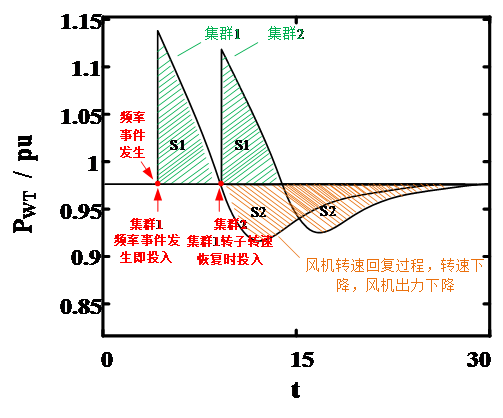
(a)梯次启动调频策略控制原理图
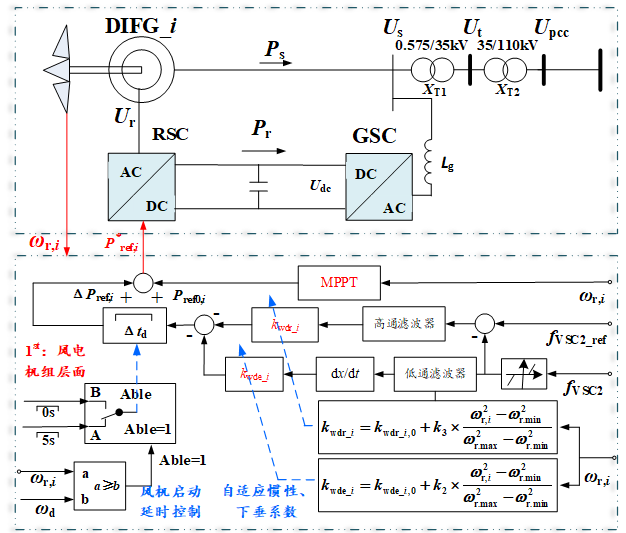
(b)风电场内风机参与一次调频控制结构图
图1 风电场内风机梯次启动调频控制策略
如图1 b)所示,首先将风电场内风机按照实时工作状态,根据转子转速分为分为两类(ωr>ωd与ωr≤ωd),为了兼顾海上风电场提供惯性支撑的效果,本文中ωd为集群分类转速,其选取方式为:将风电场内风机按照转速大小排序,将前60%数量风机的分界转速定义为ωd。后续具体步骤阐述如下:1)当系统的频率下降过快,频率偏差达到阈值时(f<49.9Hz或者f>50.1Hz),首批风电机组(ωr>ωd)投入系统调频,对频率进行惯性和下垂响应,释放转子动能,提高频率最低点;2)随着第一批参与系统频率调节的风机转速变化,惯性和下垂响应系数需要进行自适应调整,保证风机工作在安全运行范围内(0.7pu ≤ωr≤1.2pu)风机的惯性响应系数以及下垂响应系数自适应变化;3)当这批风机开始退出调频时(本文设定为预设值5s),第二批风电机组释放转子动能,补充首批调频风电机组恢复所需要的能量。通过这种次序退出的方式,可以防止风机在短时间内集体退出调频造成的巨大能量缺额,使系统的能量缺额在可控的范围内,避免出现二次频率跌落的问题。
2)系统层级:各柔性直流陆上换流站协调控制
本文在海上风电场系统陆上VSC换流站层面,提出了一种自适应下垂系数控制策略,陆上VSC换流站均采用功率电压下垂控制,并根据VSC换流站采集的本地交流母线频率信号,自适应改变换流站功率电压下垂系数,从而引导海上风电场新增功率合理地馈入陆上交流系统,从一定程度上降低频率事件发生后陆上交流系统的潮流转移程度,从而降低系统频率最大跌落值和最大频率跌落速率。自适应下垂系数的实现过程如图2所示。
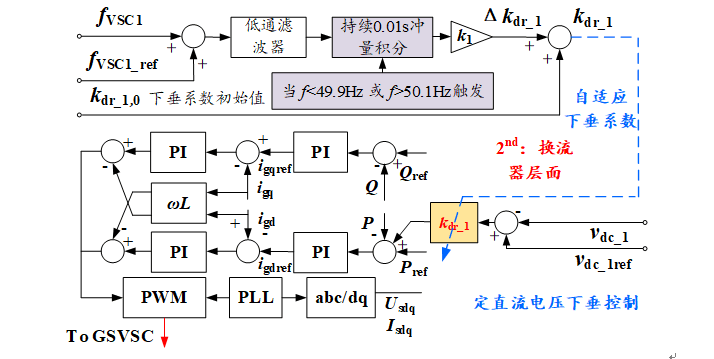
图2 陆上VSC换流站自适应下垂系数控制策略示意图
3)仿真控制结果
本文在MTALAB中构建的经VSC-MTDC并网的三区四端海上风电场交直流混联系统接线图如图3所示。其中,区域1为陆上大电网,共包含4台同步发电机(G1~G4),11个节点和10条线路。区域2和区域3为海上风电场,每个区域包含5个风机等效模型(G5~G9,G10~G14),每个风机模型可等效为15台风速相同的2.5MW风电机组集合。在稳态情况下,所有风机均采用最大功率点跟踪控制。陆上系统的额定电压为220kV,频率为50Hz。

图 3 海上风电经柔直电网并网系统
工况1:节点7负荷突增200MW
在此工况下,5s时,如图3所示系统节点7增加200MW负荷,等效风机G6、G8、G9属于集群1,探测到频率跌落超过阈值后参与系统频率调节,在风机G6、G8、G9恢复时刻(10s),属于集群2的风机G5、G7开始参与系统频率调节。同时,本文设计了不同的对比项:1)风机不参与系统频率调节,2)仅采用惯性下垂控制,3)采用其他文献提出的惯性下垂+减载控制,具体控制方式为:风机G6、G8、G9探测到频率跌落后参与系统调频,风机G5、G7减载10%运行,在风机G6、G8、G9恢复时刻(10s),风机G5、G7开始参与系统频率调节。换流站VSC_2处测得系统PCC点频率及两陆上换流站VSC1、VSC2传递功率如图4所示。
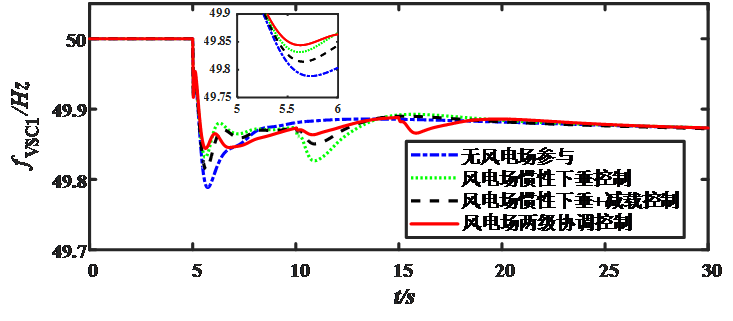
(a)换流站VSC_1处PCC点测量频率
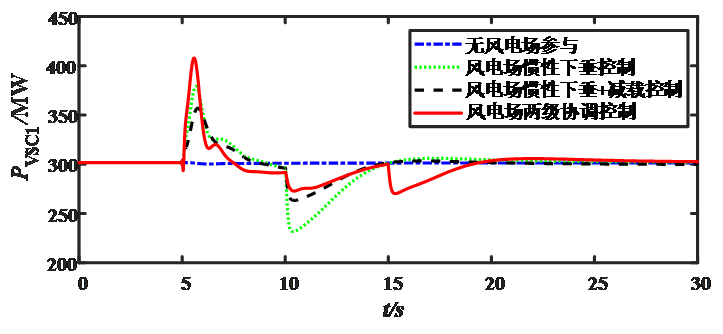
(b)换流站VSC1传递直流功率

(c)换流站VSC2传递直流功率
图4 风电场参与系统频率调节不同策略仿真结果(200MW负荷突增工况)
工况2:节点7负荷突降200MW
在工况2中,如图3所示系统在5s时,节点7降低200MW负荷,换流站VSC_2处测得系统PCC点频率及两陆上网测换流站VSC1、VSC2传递功率如图5所示
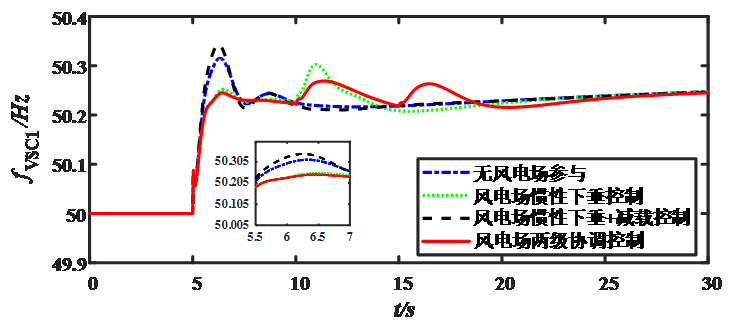
(a)换流站VSC_1处PCC点测量频率
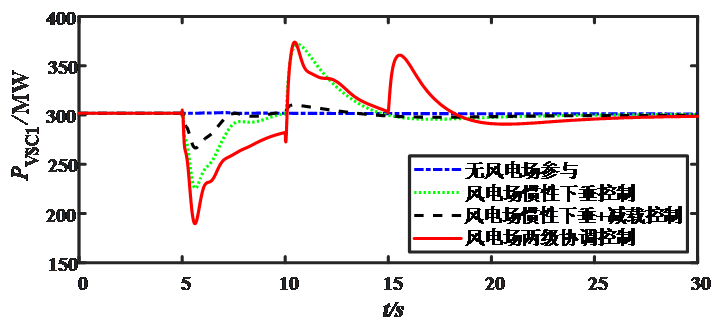
(b)换流站VSC1传递直流功率
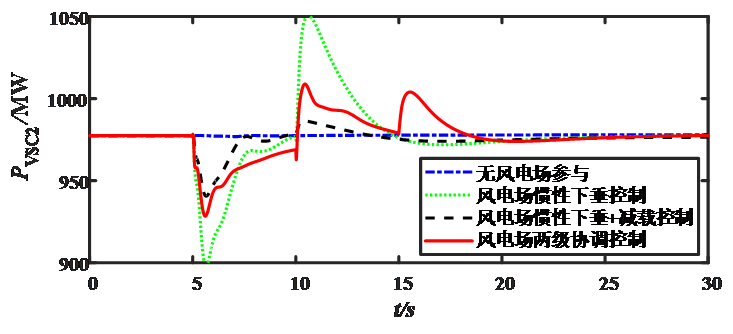
(c)换流站VSC2传递直流功率
图5 风机参与系统频率调节不同策略仿真结果(200MW负荷降低工况)
通过分析仿真结果可知,在不同负荷扰动情况下,采用本文提出的两级协调控制策略,和1)风机不参与调频、2)风机采用减载控制策略、3)风机采用惯性下垂控制这三种控制方式进行对比可以发现,在测试的节点7负荷突增、突降200MW不同工况下,采用两级协调控制,能够有效提高频率扰动后一次跌落最低点,同时也能够提高风机转子转速恢复过程中二次频率跌落最低值,从而说明了提出的两级协调控制策略的有效性。
Conclusion
This paper proposes a two-level combined control scheme to coordinate the OWFs with the VSC-MTDC system for onshore frequency support, which can reduce SFD while all WTs work at MPPT point. The proposed TLCC scheme contains two levels, the step start-up and adaptive inertial droop control on the offshore wind turbine level, and the communication-free allocation control on the onshore VSC station level.
Compared with other control schemes, the proposed TLCC scheme can reduce the frequency deviation at both the load increasing and the load decreasing situations. With the adaptive inertial and droop control, WTs whose rotor speed are high will release more kinetic energy. Consequently, the proposed TLCC scheme has better frequency support performance than that of the control scheme with constant inertial and droop coefficients. Moreover, with the step start-up control, the WTs in Cluster 2 can provide power support during WTs in Cluster 1 recover their rotor speed. Furthermore, with the communication-free allocation control strategy, the frequency support power can be allocated reasonably between different onshore VSC stations during frequency events, which will do benefit to reduce power flow change of onshore AC system, and decrease the RoCoF. Different case studies also prove the effectiveness and universality of the proposed TLCC scheme.
引文信息
Y. X. Xiong, W. Yao, J. F. Wen, S. Q. Lin, X. M. Ai, J. K. Fang, J. Y. Wen, and S. J. Cheng. "Two-Level Combined Control Scheme of VSC-MTDC Integrated Offshore Wind Farms for Onshore System Frequency Support," IEEE Trans. Power Systems, in press. doi: 10.1109/TPWRS.2020.2998579.
作者简介:
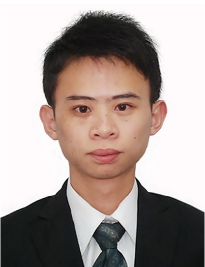 Yongxin Xiong received the B.S. degrees in electrical engineering from the Huazhong University of Science and Technology (HUST), Wuhan, China, in 2017. He is currently working toward the Ph.D. degree in electrical engineering at HUST. His current research interests include control and stability analysis of grid-integration of offshore wind farm through VSC-MTDC.
Yongxin Xiong received the B.S. degrees in electrical engineering from the Huazhong University of Science and Technology (HUST), Wuhan, China, in 2017. He is currently working toward the Ph.D. degree in electrical engineering at HUST. His current research interests include control and stability analysis of grid-integration of offshore wind farm through VSC-MTDC.
期刊简介:IEEE Transactions on Power systems,一区期刊,2019年影响因子6.807。